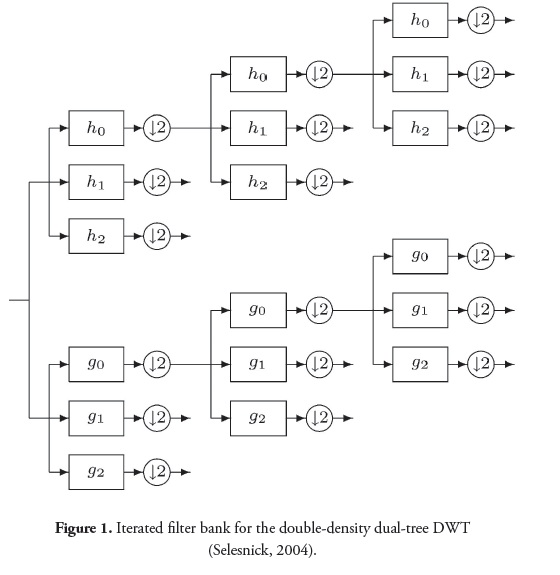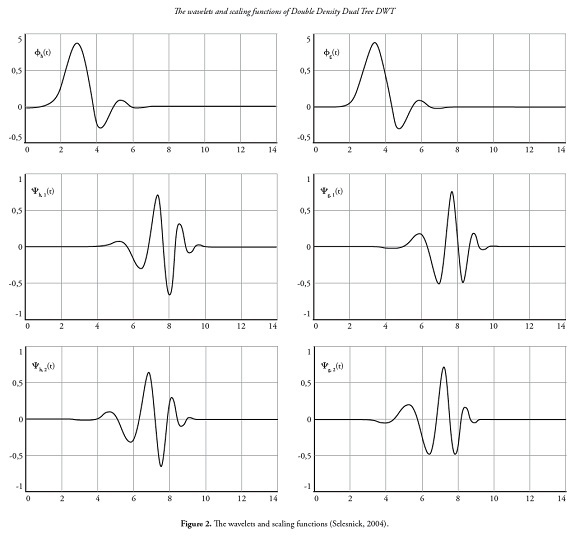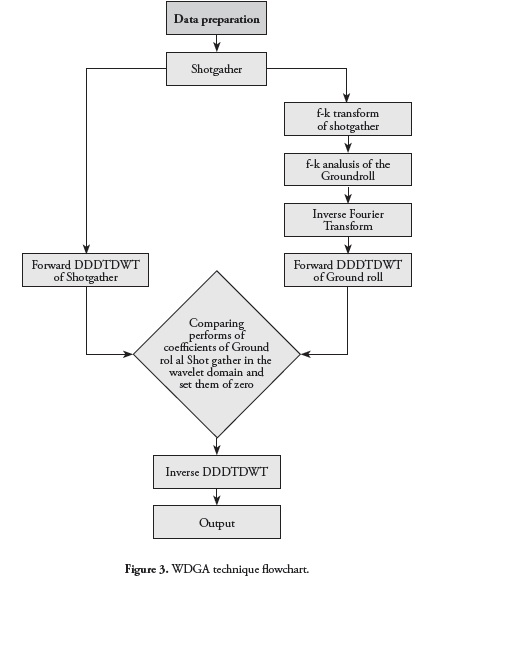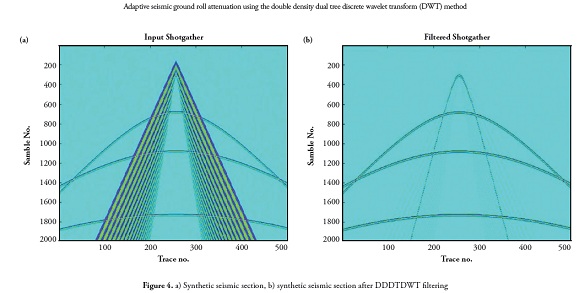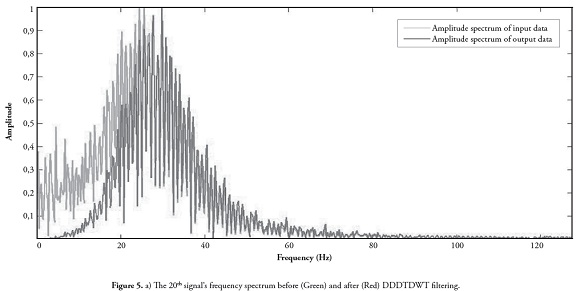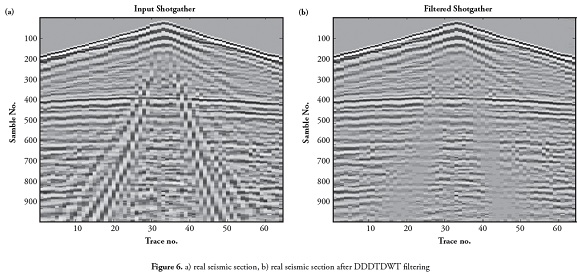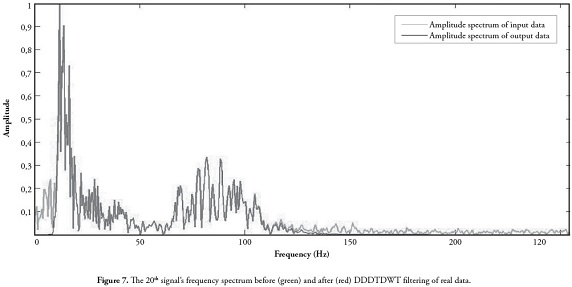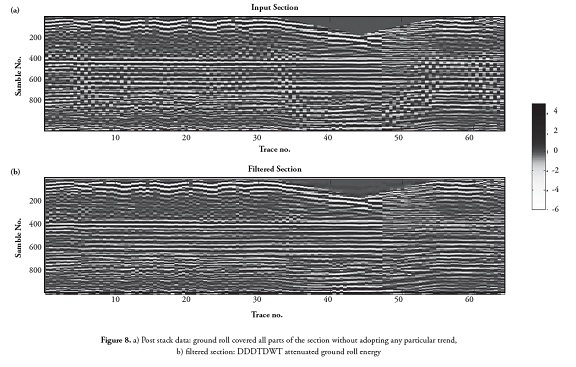Services on Demand
Journal
Article
Indicators
-
 Cited by SciELO
Cited by SciELO -
 Access statistics
Access statistics
Related links
-
 Cited by Google
Cited by Google -
 Similars in
SciELO
Similars in
SciELO -
 Similars in Google
Similars in Google
Share
Earth Sciences Research Journal
Print version ISSN 1794-6190
Earth Sci. Res. J. vol.16 no.2 Bogotá July/Dec. 2012
Adaptive seismic ground roll attenuation using the double density dual tree discrete wavelet transform (DWT) method
Ali Reza Goudarzi1 and Mohammad Ali Riahi2
1 Institute of Geophysics, Tehran University, Islamic Republic of Iran. E-mail: aligoudarzi@ut.ac.ir
2 Institute of Geophysics, Tehran University, Islamic Republic of Iran, PhD in Exploration Geophysics (Associate Professor of Geophysics).
Phone: +98 (21)61118219. E-mail: mariahi@ut.ac.ir
Record
Manuscript received: 14/10/2011
Accepted for publications: 06/05/2012
ABSTRACT
Seismologists working on the reflection of seismic data have been dealing with noise and trying to attenuate noise as much as possible without damaging a particular signal. Many methods have been used to remove noise types, each being partially effective. None of the transforms have been ideal and, even at the point of transform, noise becomes added to data. The double density dual tree (DDDT) discrete wavelet transform (DWT) method was used in this paper to attenuate noise in pre-stack and post-stack seismic data.
Wavelet domain ground roll analysis (WDGA) was used for finding ground roll energy in the wavelet domain; it is a substitute method for thresholding in seismic data processing.
The DDDTDWT method has four wavelets and two scaling functions. Using this method, shot gather data decomposes to sub-scales and each scale contains coefficients related to a particular signal. The procedure involved applying distinct wavelets and scaling functions to data and then eliminating the coefficient of noise from inverse DDDTDWT using the WDGA technique. The inverse transform provided a section without noise; double density DWT and dual tree DWT methods were combined (i.e. each method having its own characteristics and advantages).
Keywords: seismic, noise, wavelet transform, shot gather, stack section, WDGA.
RESUMEN
Los sismólogos que trabajan en la reflexión de los datos sísmicos se han ocupado del ruido y en tratar de atenuarlo tanto como sea posible sin dañar una señal particular. Muchos métodos se han utilizado para eliminar ciertos tipos de ruido, cada uno siendo parcialmente efectivo. Ninguna de las transformadas han sido ideal e incluso en el punto de transformación, el ruido es añadido a los datos. El árbol de doble densidad dual (DDDT) y el método de transformada de ondicula discreta (DWT) fueron los métodos utilizados en este trabajo para atenuar el ruido en los datos sísmicos la sección preapilda y postapilada.
El análisis de ground roll en el dominio de la ondícula (WDGA) se utilizó para encontrar su energía. Este es un método sustituto de umbralización en procesamiento de datos sísmicos.
El método DDDTDWT tiene cuatro ondiculas y dos funciones escalares. Usando este método, datos shot gather fueron descompuestos a subescalas, donde cada escala contiene coeficientes relacionados a una señal particular. El procedimiento consistió en aplicar distintas ondiculas y funciones escalares a los datos y posteriormente eliminar el coeficiente de ruido a partir de la inversión de DDDTDWT utilizando la técnica WDGA. La transformada inversa proporcionó una sección sin ruido; los métodos de doble densidad DWT y doble árbol DWT se combinaron (es decir, cada método tiene sus propias características y ventajas).
Palabras claves: Sismica, ruido, transformada ondicula, Disparo- receptores , sección apilada, WDGA.
Introduction
This study presents a wavelet-transform-based method and wavelet domain ground roll analysis (WDGA) technique for seismic ground roll reduction. The double density dual tree (DDDT) discrete wavelet transform (DWT) was used with the WDGA technique for seismic denoising.
Exploration seismology has usually dealt with a variety of noise having determined and undetermined sources. This paper was aimed at attenuating ground roll using the DDDTDWT method on post-stack (residual noise) and pre-stack data.
More than two-thirds of total generated seismic energy is imparted into Rayleigh waves in most surface seismic surveys when a compressional wave source is used (Richart et al., 1970; Choon B, Park et al., 1999).
Receiver arrays are used to attenuate undesired coherent noise in certain wave numbers. Shot hole depth and charge size are the important parameters in surface wave generation in land seismic acquisition. Since the surface’s physical conditions can vary significantly along a seismic line, measurements taken in the field to eliminate surface waves may be insufficient (Saatcilar R and Canitez N, 1988).
In recent years, Halliday D (2011) has used an adaptive interferometry method for ground-roll suppression and Henley D (2003) has tried to attenuate coherent noise in the radial trace domain. Neelmani et al., (2008) used the curvelet domain to attenuate coherent and random noise in seismic section. More recently, Bonar and Sacchi (2012) have applied a nonlocal means algorithm to seismic noise attenuation.
Signal and noise frequency and time domain together have considerable overlap. Hence, the Fourier transform for noise removal is not always quite efficient because its basic premise is that stationary signal and seismic signals have non-stationary characteristics. The DWT technique can be a viable alternative for the removal of coherent and random noise in seismic data processing. Wavelet transform is a simple and reliable tool for signal and image processing and has overcome the limitations of the Fourier transform. The conventional DWT uses a wavelet and scaling function; this method was used by Deighan et al., (1997) to remove ground roll noise. Defects in this type of DWT are aliasing, its shift invariant property and a lack of directivity in higher dimensions (because coefficients related to trace ground rolls traced at the same scale are different and hamper making all coefficients zero, ground rolls therefore not being completely removed). Surface waves provide common sources of noise in seismic land data. Creating surface waves is closely related to regional geology and the location of sources and receivers (Al-Husseini et al, 1981; Dobrin 1951).
Deeper sections’ seismic data is similar in bandwidth to that of ground rolls, but ground rolls have higher amplitude. A regular filtering method is 1D frequency filtering; however, the intersection between seismic signal and noise frequency time components means that 1D frequency filtering is not a useful tool for such purpose. Another technique that is often used is 2D Fourier transform or f-k transform; nevertheless, it disagrees with seismic data’s natural behaviour because of stationary signal assumptions. Also, there is no distinct border between signal and noise in 2D Fourier transform, consequently it distorts a seismic signal because of windowing and changes its frequency component. The DWT applied by Deighan et al., (1997) had various restrictions; different techniques have been proposed to overcome such restrictions, including aliasing which may happen because of DWT’s low redundancy factor. It is also a shift-invariant transform making denoising difficult in practice and it cannot be expanded to M-dimensional applications (i.e. difficult directivity). It has been suggested that a proper wavelet could be applied to avoid aliasing and reduce the frequency band of scales intersection in the wavelet domain. Some newer wavelet transform structures have been introduced instead of critically sampled DWT. A common type of DWT is UDWT which was introduced by Guo et al., (1995); redundancy grows with level and is perfectly shift-invariant in this method. UDWT’s redundancy characteristics generate a huge amount of information which cannot be simply applied to seismic data processing because it is time-consuming. UDWT can thus be replaced by practical methods.
After methods were introduced by Kingsbury (2001) and Selesnick (2001), a combination of such methods (Selesnick et al., 2005) was applied to denoising and image processing. The proposed techniques were based on multi-wavelet frames to avoid aliasing characteristics and achieve better time-frequency representation between scales. Kingsbury applied the DWT in separate parallel trees; he used two wavelets that were approximately Hilbert transform pairs (a dual tree CWT uses two real DWTs: the first DWT gives the real part of the transform while the second DWT gives the imaginary part (Selesnick et al., 2005)). Selesnick (2001) used a similar strategy but one of the wavelets had one sample delay and the wavelets were real.
The double density discrete wavelet transform (DDDWT) was based on oversampled FIR filter banks. This method has much smoother wavelets than orthonormal wavelets (like Daubechies’ orthonormal wavelets) from the same support. As ground roll occurs at higher scales, it can be picked up and suppressed clearly in the wavelet domain. DDDWT and DTCWT are nearly shift invariant and have redundancy factors of 2, so they might be considered as perfect substitute methods. DDDTDWT uses their advantages in signal processing and has a redundancy factor of 4.
The wavelet domain ground roll analysis technique (WDGA) has been used here to address ground roll coefficients in the wavelet domain, each signal being analysed to scales and each scale has its time-frequency resolution. Note that frequency was related to scales (Abry, 1997):
where a was a scale, Î was the sampling period, fc was the centre frequency of a wavelet in Hz and fa was pseudo-frequency corresponding to scale a, in Hz.
Methodology
Ψh, i(t) and Ψg, i(t) (For i = 1, 2) were wavelets in the DDDTDWT method. Wavelets were applied with a sample apart and were nearly the same, so that Ψh, 1(t) â Ψh, 2(t –0.5) . Other pairs had an approximate Hilbert pair of wavelets so that ch, 1(t) â H {Ψh, 2(t)}. The results gave wavelets where the zero moments had to be determined, having a high degree of smoothness and the shortest possible length. The DDDTDWT method is nearly shift-invariant and has a redundancy factor of 4.
Double density DWT is nearly invariant with shift, it uses a scaling function and two wavelet functions, it can remove noise, its redundancy factor is 2 and wavelets are smooth and their lengths are minimised. The dual tree DWT method is almost invariant with shift, it is a fairly good approximation for continuous wavelet transform, its redundancy factor is 2, time-frequency width is enhanced and wavelet length is minimised.
The two methods do have differences, such as both wavelets become linked together in quite different manners, the degree of freedom in dual tree DWT design is less than that of double density DWT and filter bank structure is distinct from each other. DDDTDWT has advantages over both these methods. The relationship between wavelets is:
Figure 1 shows the DDDT DWT filter bank. Dual tree DWT uses critically-sampled DWT and the structure is such that the filter banks are applied iteratively and in parallel. Reconstruction filters in the filter bank are time-reversed analysis filters. The filters applied in this study had the following features which had to satisfy certain conditions: they had to satisfy perfect reconstruction, wavelets had to be approximately Hilbert pairs, they had to satisfy zero moment property and they had to have a minimum length.
Figure 2 shows the wavelets considered for seismic data processing (Selesnick et al., 2004). Selesnick et al., (2005) encountered four problems and solved them by using the DDDTDWT technique used here. Oscillations mean that since wavelets are band pass functions then wavelet coefficients tend to oscillate positively and negatively around singularities. Shift variance means that a small shift in the signal greatly perturbs wavelet coefficient oscillation pattern around singularities. Substantial aliasing arises from wavelet coefficient samples’ wide spacing or, equivalently, the fact that wavelet coefficients are computed via iterated discrete-time down-sampling operations interspersed with non-ideal low-pass and high-pass filters. A lack of directionality would concern multi-dimension wavelet transforms (but was not the case in this study).
Unlike DWT based on real-valued oscillating wavelets, the Fourier transform is based on complex-valued oscillating sinusoids. The oscillating cosine and sine components (real and imaginary parts, respectively) form a Hilbert transform pair (Selesnick et al., 2005).
The Fourier transform does not suffer from these problems. Fourier transform magnitude does not oscillate positively and negatively but rather provides a smooth positive envelope in the Fourier domain. Fourier transform magnitude is perfectly shift-invariant, having a simple linear phase offset encoding the shift. Fourier coefficients are not aliased and do not rely on a complicated aliasing cancellation property to reconstruct a signal. The M-D Fourier basis sinusoids are highly directional plane waves (Selesnick et al., 2005).
The idea behind DDDTDWT is to use characteristics from Fourierbased methods but in short support wavelets and using a filter bank parallel strategy.
Thresholding
The following nonlinear transform was applied to empirical wavelet coefficients to suppress noise: F (x) = x I (|x| > t) where t was a certain threshold. The choice of threshold was a very delicate and important statistical problem.
A large threshold leads to attenuating the seismic signal inside the ground roll whereas a small threshold provides inappropriate denoising. Theoretical considerations yielded the following threshold value:where n was input vector length and ð2 variance of noise. The only difference between hard and soft thresholding procedures lie in the choice of nonlinear transform on empirical wavelet coefficients. The following nonlinear transform was used for soft thresholding:
where t was a thresholding parameter.
Soft thresholding, like hard thresholding, has encountered similar problems in seismic denoising, especially for ground roll elimination. Thresholding is well behaved for seismic random noise attenuation but causes trouble for data-processors for coherent noise attenuation. There is a trade-off between noise attenuation and signal damage; a practical approach was thus needed to overcome such restriction.
The wavelet domain ground roll analysis technique (WDGA) was thus used to address ground roll coefficients in the wavelet domain, each signal analysed to scales and each scale having its time-frequency resolution, frequency being related to scales (Abry, 1997). It was obvious that ground roll low-frequency signal would be seen in low frequency scales, based on applying a wavelet transform strategy. Filter banks of these lowfrequency scales may be in lower scales or upper scales. Setting thresholding value depends on user experience; if a user chooses an incorrect thresholding value then thresholding algorithms go through all the scales in a particular wavelet domain. Thresholding value means limiting to keep or kill a coefficient and will not ask if it is a part of a particular signal or not.
Where ground roll is based on the level of decomposition present in a few low-frequency scales, then thresholding procedures are inappropriate for attenuating them.
The WDGA strategy used in this paper consisted of:
1) transforming seismic data to the f-k domain and analysing it;
2) eliminating the energy relating to a signal because of ground roll linear characteristics in the Fourier domain;
3) the inverse transform of the analysed data in the Fourier domain providing the seismic section containing ground roll energy;
4) transforming the section containing signal and ground roll energy to the wavelet domain;
5) transforming the analysed section containing just ground roll energy to the wavelet domain by the same level of decomposition as the previous step;
6) comparing two domains from steps 4 and 5 and the coefficients present in step 5 from step 4 set to zero; and
7) step 6 inverse DWT regarding time domain providing a section with no ground roll energy.
Figure 3 shows a flowchart of the WDGA technique.
DDDTDWT resolution level was controlled by signal length. Maximum value was used for better time frequency representation. Two types of transform were thus applied to a chain, where each transform’s abilities helped to diagnose noise having a linear pattern. Linear analysis was used for ground roll elimination and it was believed that the WDGA technique could attenuate each linear complex noise in the wavelet domain, e.g. air waves, multiples and tube waves. The main point concerned the choice of transform (in the chain) to be applied before discrete wavelet transform. No transform in seismic signal processing was ideal and perfect, but a combination of them led to reliable data-processing results.
Application
Seismic data usually involves the following equation:
where x(t) was the earth’s impulse response. The source wavelet w(t) was convolved with x(t), then noise n(t) was added to the equation (n(t) containing all types of noise). This noise could not be eliminated completely because its time and frequency overlapped the seismic signal.
The wavelet used in generating a synthetic seismogram was a Ricker wavelet having 30 Hz central frequency; the ground rolls were in the 5-15 Hz frequency range. Figure 4a shows the synthetic section; this shot gather contained four reflectors where ground roll masked them, especially the first low velocity reflector. Ground rolls have low frequency and high amplitude, features which can be very useful for attenuating ground roll. The DDDTDWT method was thus used here; the data involved 2050 samples and Fig. 4b gives the sampling interval as 4 ms. Selected traces’ frequency spectra can be seen before and after DDDTDWT filtering.
Note in Fig. 5 that noise amplitude in the 5-15 Hz frequency range has been attenuated. The first low velocity reflector appeared successfully and other reflectors’ continuity was enhanced. The DDDTDWT method (due to time frequency representation) eliminated all ground roll energy while reflector continuity was enhanced without damaging the signal. Note that the DDDTDWT method preserved each frequency’s amplitude in the pass band. Good shift invariance (and wavelet smoothness) required that cascaded multirate filters’ frequency response side lobes be small (Kingsbury (2001).
After applying the method to synthetic data, the method’s performance was investigated on real shot gathers. The real data had 1.92 second record length with 2 ms sampling interval, and the trace interval was 20m.
Ground roll frequency band in this example was estimated to be 3-12 Hz by f-k mapping. DDDTDWT was applied to attenuate ground roll (Figure 6); this method had an acceptable result and noise became significantly reduced. Events in a deeper part of the section had more continuity and signal distortion did not happen with this filtering technique. The signal was still visible and most ground-roll energy was attenuated. Fig. 7 shows the 20th spectrum’s data trace amplitude and its filtered section.
The second type of data used here was a stacked section having 2 ms sampling interval, distance between adjacent traces being 25 m. Record length was 1.92 seconds or 960 samples. The wavelet transform method’s efficiency was then tested on shot gather for remnant noise reduction of post stack data. All shot gather noise was attenuated and true velocity analysed to give the best results; the data was then stacked without ground roll attenuation using these velocity values (Figure 8a).
Residual noise in post stack data occurred in some field data examples with complicated behaviour of ground roll or complex geological areas being generated; it might thus be of interest for geophysicists to investigate filtering methods’ behaviour in this respect. Fig. 8 shows noisy and denoised sections.
Comparing the sections shown in Fig. 8, it can be seen that the reflections were quite recovered without distortion, and horizontal continuity was extended and improved by using the DDDTDWT method. it is thus worth emphasising that DDDTDWT can be used to attenuate ground roll, having an application to both synthetic and real data. The algorithm produced satisfactory results regarding the preservation of waveform, frequency and bandwidth and improved resolution of seismic data. Filtered output had better S/N ratios and reflected signals’ trace-to-trace continuity.
Conclusions
The DDDTDWT method was used for seismic ground roll attenuation in this study. DDDTDWT is an efficient way to filter seismic data; this method does not suffer from conventional DWT’s limitations. It can be quickly applied to a large volume of data and coherent noise in seismic data was successfully attenuated with this type of discrete wavelet transform.
The WDGA is an efficient and applicable method for seismic denoising and could be a substitute method for thresholding. WDGA gains from two transforms: a regular transform (e.g. f-k) and discrete wavelet transform; the latter overcame Fourier restrictions. This denoising method preserved signal information and generated little processing-related noise; filtering partly reduced noise.
The advantage of DDDTDWT, in conjunction with WDGA, was that ground roll was suppressed by insignificant distortion of a particular signal. A reflection seismogram’s vertical resolution was not affected by applying DDDTDWT, as happens when using frequency filters.
Acknowledgments
We would like to thank the University of Tehran’s Institute of Geophysics and the Earth Physics Department which supported us in this study. We appreciate the kind advice given by Professor Kingsbury who helped us in this study. We would like to offer our regards and blessings to all who supported us in any respect during the completion of the study.
References
Abry, P. (1997), Ondelettes et turbulence. Multiresolutions, algorithmes de decomposition, invariance d echelles, Diderot Editeur, Paris. [ Links ]
Al-Husseini, M. I. , Glover, J. B. , and Barley, B. J. , 1981, Dispersion patterns of the ground-roll in eastern Saudi Arabia: Geophysics, 43, 121-137. [ Links ]
Al-Yahya, K. M. , 1991, Application of the partial Karhunen-Loeve transform to suppress random noise in seismic sections: Geophys. Prosp., 39,77-93. [ Links ]
Alsdorf, D. , 1997. , Noise Reduction In Seismic Data Using Fourier Correlation Coefficient Filtering. , Geophysics, v62, no. 5, pp. 1617-1627. [ Links ]
Baussard, A. , Nicolier, F. , and Truchetet. F. , 2004, Rational multiresolution analysis and fast wavelet transform: application to wavelet shrinkage denoising. Signal Processing, 84(10):1735 1747. [ Links ]
Bayram, I. , and Selesnick. I. W. , 2009, Frequency-domain design of overcomplete rational-dilation wavelet transforms. IEEE Trans. Signal Process. , 57(8):2957 2972. [ Links ]
Beresford-Smith, G. , and Rango, R. , 1988, Dispersive noise removal in t-x space: Application to Arctic data: Geophysics, 53, 346-358. [ Links ]
Berkner, K. , and Wells, Jr, R. O. , 1998, A correlation-dependent model for denoising via nonorthogonal wavelet transforms. Technical Report CML TR98-07, Computational Mathematics Laboratory, Rice University, [ Links ]
Bonar D., Sacchi M., 2012, Denoising seismic data using the nonlocal means algorithm, Geophysics. Vol. 77, No. 1 (January-February 2012); P. A5 A8. [ Links ]
Brown, J. C. , 1991, Calculation of a constant Q spectral transform. J. Acoust. Soc. Am. , 89(1):425 434. [ Links ]
Canales, L. L. , 1984, Random noise reduction: Presented at the 54th Annual International Meeting, SEG. [ Links ]
Cary, P. W. ,2009. , Ground roll attenuation with adaptive eigenimage filtering., SEG Houston 2009 International Exposition and Annual Meeting [ Links ]
Chui, C. K. , 1992, An introduction to wavelets: Academic Press Inc. [ Links ]
Deighan, A. J. , and Watts, D. R. , 1997, Ground-roll suppression using the wavelet transform: Geophysics, 62, 1896 1903. [ Links ]
Dobrin, M. B., 1951, Dispersion in seismic surface waves: Geophysics, 16, 63-80. [ Links ]
Donoho, D. L. 1995, De-Noising by Soft-Thresholding: IEEE Transactions on Information Theory, Vol. 41, NO. 3, 613-627. [ Links ]
Guo, H,1995,-Theory and Applications of the Shift-Invariant, Time- Varying and Undecimated Wavelet Transforms,-Master Thesis, Rice University-. [ Links ]
HALLIDAY D.,2011, Adaptive interferometry for ground-roll suppression, The Leading Edge, May 2011, p532-p537. [ Links ]
Henley D. C., 2003, Coherent noise attenuation in the radial trace domain, GEOPHYSICS, VOL. 68, NO. 4 (JULY-AUGUST 2003); P. 1408 1416, [ Links ]
Kingsbury, N. G. , 1998,The dual-tree complex wavelet transform: a new technique for shift invariance and directional filters. In Proceedings of the Eighth IEEE DSP Workshop, Utah, August 9-12. [ Links ]
Kingsbury , N. G. 2001, Complex wavelets for shift invariant analysis and filtering of signals. Applied and Computational Harmonic Analysis, 10(3):234-253. [ Links ]
Lang, M. , Guo, H. , Odegard,, J. E. , Burrus, C. S. , Wells, R. O. , MeVis, Jr. ,1996,-Noise Reduction Using an Undecimated Discrete Wavelet Transform,- IEEE Signal ProcessingLetters, pp. 10-12. [ Links ]
Nason, G. P. , and Siverman, B. W. 1995, The stationary wavelet transform and some statistical applications, in A. Antoniadis, ed. , Wavelets and statistics: Springer-Verlag, 281 300. [ Links ]
Neelmani R., Baumstein A. I., and Gillard D. G.,2008, Coherent and random noise attenuation using the curvelet transform, The Leading Edge, february 2008, p240-248. [ Links ]
Porsani, M.J. ,2009,. Ground-roll attenuation based on SVD filtering,. SEG Houston 2009 International Exposition and Annual Meeting [ Links ]
Selesnick, I. W. , 1999, Interpolating multiwavelet bases and the sampling theorem. IEEE Trans. on Signal Processing, 47(6):1615-1621. [ Links ]
Selesnick, I. W., Baraniuk . R. G., and Kingsbury, N., 2005, The dualtree complex wavelet transform - A coherent framework for multiscale signal and image processing. IEEE Signal Processing Magazine, 22(6):123-151. [ Links ]
Selesnick, I. W. ,2004 The double-density dual-tree DWT. IEEE Trans. on Signal Processing, 52(5):1304-1314. [ Links ]
Selesnick , I. W., and Burrus, C. S,. 1998 Maximally at low-pass FIR filters with reduced delay. IEEE Trans. on Circuits and Systems II,45(1):53-68. [ Links ]
Selesnick, I. W. , and Sendur, l,. 2000, Smooth wavelet tight frames with denoising applications. In Proc. IEEE Int. Conf. Acoust. , Speech, Signal Processing (ICASSP). [ Links ]
Selesnick , I. W. , 2011, Wavelet Transform with Tunable Q-Factor. IEEE TRANSACTIONS ON SIGNAL PROCESSING , 1-18. [ Links ]
Selesnick , I. W. ,2001, The double density DWT. In A. Petrosian and F. G. Meyer, editors, Wavelets in Signal and Image Analysis: From Theory to Practice. Kluwer. [ Links ]
Vetterli, M. , 1992, Wavelets and filter banks: theory and design: IEEE Trans. Sig. Proc. , 40, 2207-2232. [ Links ]














